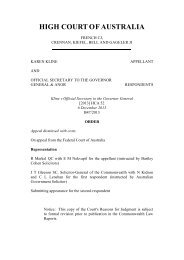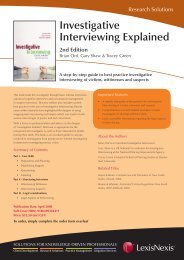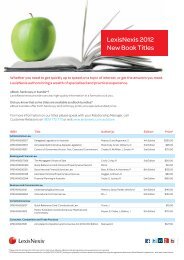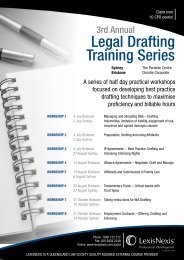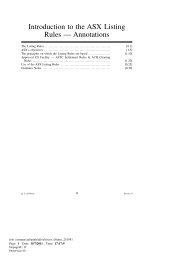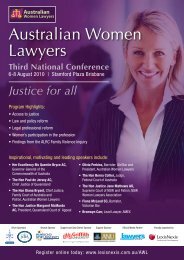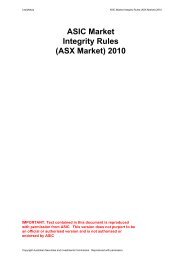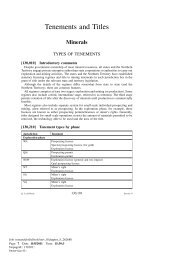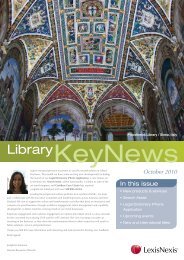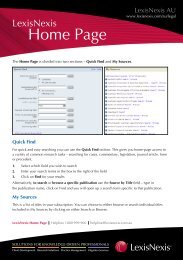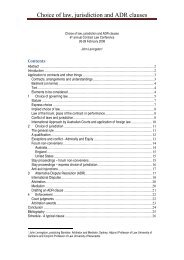Torts: Cases and Commentary - LexisNexis
Torts: Cases and Commentary - LexisNexis
Torts: Cases and Commentary - LexisNexis
Create successful ePaper yourself
Turn your PDF publications into a flip-book with our unique Google optimized e-Paper software.
10.15 <strong>Cases</strong> regarding the exclusion of the plaintiff’s evidence<br />
<br />
Neal v Ambulance Service of New South Wales [2008] NSWCA 346: See<br />
discussion at [40] – [42] regarding the practical effect of the exclusion:<br />
“Whatever the real purpose of the provision, the issue for determination is<br />
how a court is now to identify what course the plaintiff would have taken,<br />
absent negligence. That assessment might include evidence of the following:<br />
(a) conduct of the plaintiff at or about the relevant time; (b) evidence of the<br />
plaintiff as to how he or she might have felt about particular matters; (c)<br />
evidence of others in a position to assess the conduct of the plaintiff <strong>and</strong> his<br />
or her apparent feelings or motivations, <strong>and</strong> (d) other matters which might<br />
have influenced the plaintiff….Properly understood, the prohibition on<br />
evidence from the plaintiff about what he or she would have done is of quite<br />
limited scope. Thus, the plaintiff cannot say, “If I had been taken to hospital I<br />
would have agreed to medical assessment <strong>and</strong> treatment”. Indeed, as the<br />
Negligence Review recognised, such evidence would be largely worthless.<br />
However, the plaintiff might have explained such evidence along the following<br />
lines: “I recall on the trip to the police station that I began to fell less well; my<br />
state of inebriation was also diminishing; I began to worry about the pain in<br />
my head ….”…. That evidence (entirely hypothetical in the present case) would<br />
not be inadmissible. If accepted, it might provide a powerful reason for<br />
discounting any inference as to future conduct drawn from the past refusal of<br />
treatment. It would constitute evidence as to the plaintiff’s position, beliefs<br />
<strong>and</strong> fears. Because an inference would need to be drawn from that evidence,<br />
no doubt the court would take into account the likely response of a<br />
reasonable person in such circumstances. That is consistent with the Act<br />
requiring that the matter be determined “subjectively in the light of all<br />
relevant circumstances”.<br />
10.20 Other case examples<br />
<br />
<br />
<br />
Papa v Sullivan Nicolaides Pty Limited [2010] QSC 364. The defendant firm of<br />
medical pathologists monitored the INR levels of the plaintiff but did not tell<br />
her that her Warfarin levels were above the target range. The plaintiff went<br />
on to have a stroke. The plaintiff succeeded in her claim that the pathologists<br />
should have notified the plaintiff <strong>and</strong> her general practitioner, <strong>and</strong> on<br />
causation.<br />
Wallace v Ramsay Health Care Ltd [2010] NSWSC 518. Spinal surgery. Failure<br />
to warn of a material risk proven, however causation not proven as referable<br />
damage did not arise <strong>and</strong> plaintiff would not have refused the surgery in any<br />
event.<br />
Hookey v Paterno [2009] VSCA 48: Orthognathic surgery for correction of<br />
Class II malocclusion in 49 year old female smoker. Duty to warn of risk of<br />
19



